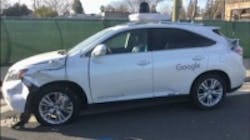Google self-driving car collides with bus in minor accident
For the first time in several years, aGoogle self-driving car caused a crash on public roads, as a driverless Lexus SUV was filmedhitting a public bus in Mountain View, CA, USA.
As some will recall, Google introduced its first fully-functionalself-driving car to the street of California last year. This car’s vision system included a number of different components, including LIDAR laser remote sensing system from Velodyne Lidar, which is on the top of the roof, as well as cameras mounted on the exterior of the vehicle in pairs to provide stereo vision.
In addition to the LIDAR and stereo vision technologies, the car also utilizes radar to adjust the throttle and brakes continuously, essentially acting as adaptive cruise control while taking into account the movement of cars around the vehicle. Software from Google integrates the data from the vision system at a rate up to 1 GB/s to build a map of the car’s position on the road.
In this particular case, the car’s system was unable to avoid crashing into a bus, crumpling the front left side of the Lexus, flattening a tire, and tearing off the car’s radar system, according toThe Guardian. The accident took place on February 14, and according to the Santa Clara Valley transportation authority, was not the fault of the bus driver, though an independent claims adjuster has not yet determined liability. Google has accepted at least "partial responsibility," acknowledging that its car had made a mistake that led to a collision.
"This is a classic example of the negotiation that’s a normal part of driving – we’re all trying to predict each other’s movements. In this case, we clearly bear some responsibility, because if our car hadn’t moved there wouldn’t have been a collision," Google wrote of the incident.
Google’s software that controls the cars is programmed to follow all traffic laws and drive conservatively. In this case, the algorithms that rule the vehicle’s computer make its decision to try and slip in front of the bus surprising, suggested The Guardian article. Google said that it has adjusted its software to "more deeply understand that buses and other large vehicles are less likely to yield to us than other types of vehicles."
Between September 2014 and November, Google reported that its self-driving car prototypes drove themselves about 400,000 miles on city streets near itsSilicon Valley headquarters without causing a collision. Since road testing began in spring of 2014, however, Google cars have been hit nearly a dozen times on the streets in or around its Mountain View headquarters.
View theGuardian article.
Share new products that you think are particularly interesting or helpful by contactingJames Carroll, Senior Web Editor, Vision Systems Design.
To receive news like this in your inbox,click here.
Share your comments, tips, or questions in ourcomments section below.
Join ourLinkedIn group | Like us on Facebook | Follow us on Twitter
About the Author

James Carroll
Former VSD Editor James Carroll joined the team 2013. Carroll covered machine vision and imaging from numerous angles, including application stories, industry news, market updates, and new products. In addition to writing and editing articles, Carroll managed the Innovators Awards program and webcasts.
